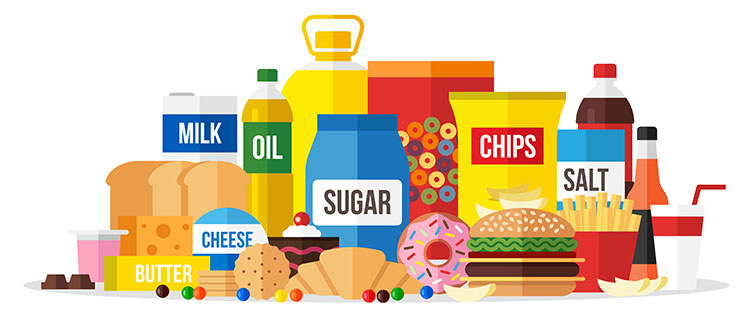Pediatricians Raise Alarm About the 10,000 Chemicals Allowed in Food and Food Packaging
 |
| Jamie McConnell Director of Programs & Policy |
The American Academy of Pediatrics (AAP) recently released a policy statement calling for reforms to the way food additives are regulated in the United States. At the heart of the statement are concerns the AAP has over the harmful impacts chemicals used as food additives are having on children’s health.
The AAP’s statement highlights the fact that over 10,000 chemicals are allowed in food and food packaging in the US. Yet there is very little data about the safety of these chemicals. Consider this: an evaluation of almost 4,000 food additives found that only 263 (6.7%) had reproductive toxicology data, only 2 (yes 2) had developmental toxicology data and a whooping 63.9% had no data on the lethal dose or an oral toxicology study. In short, the lack of information on these chemicals is alarming.
What little we do know is not good. In particular, the AAP calls out certain chemicals used as food additives or in food packaging that studies show may pose health risks, especially to young children. Children are especially vulnerable to chemical exposure because they eat and drink more than adults and their bodies are still developing (thus, a chemical may impact their development in a way that would not impact an adult). The list of chemicals of particular concern in AAP’s policy statement include the following endocrine disrupters:
- Bisphenols (used in the liners of canned goods and some plastics)
- Phthalates (used in adhesives, lubricants, and plasticizers during the manufacturing process)
- Nonpersistent pesticides
- perfluoroalkyl chemicals (PFCs) (used in grease-proof paper and packaging)
- perchlorate (an antistatic agent used for plastic packaging and a byproduct of cleaning food manufacturing machines)
In addition, the AAP calls out artificial food colors (linked to ADHD) and nitrates/nitrites (linked to cancer and hormone disruption). The Environmental Working Group has a list of 12 food additives to avoid.
In order to protect children, the AAP’s statement contains specific policy recommendations including — better evaluation and testing of chemicals used as food additives and food packaging, closing data gaps, prioritization of testing chemicals currently approved for use, and more stringent and transparent labeling of additives.
The AAP also gives recommendations for reducing exposure in the short term like:
- Eat more fresh or frozen fruits and vegetables
- Avoid processed meats
- Avoid microwaving food or beverages in plastic, if possible
- Avoid placing plastics in the dishwasher
- Use alternatives to plastic, such as glass or stainless steel, when possible
- Avoid plastics with recycling codes 3 (phthalates), 6 (styrene), and 7 (bisphenols) unless plastics are labeled as “biobased” or “greenware”
- Wash your hands before handling food and wash fruits and vegetables
Some of these recommendations are easier to follow than others (like washing your hands). But of course not everyone has the economic means and access to buy glass and stainless-steel containers, or fresh fruit and vegetables. And we know exposure to some of these chemicals like BPA disproportionately impact minority, and low-income, people. For example, African Americans have higher concentration of BPA in their bodies, and levels of BPA have correlated with family income.
That’s where better, stronger regulation comes in. We need blanket protection from harmful chemicals that provides protection for everyone. In absence of true policy reforms like the ones AAP is recommending, people of color and, people who are low-income, will bear the brunt of exposure.
What to learn more or get involved? There are some great groups doing on work on food additives and chemicals used in food packaging. Check them out and take action!
Environmental Health Strategy Center




And yet not a word about the toxic chemical cocktails spewing from dryer vents and off clothes.
GMOs are causing havoc with our children and your seeing the results in older adults today due to the poisoning of our food supply. Until Monsatan/Bayer and their ilk are brought down this will only continue. There is no oversight whatsoever today so choose your food wisely, eat organic, grow your own and stay away convenience foods. Our water is even worse, which not only contains fluoride but tons of pharmaceuticals and insecticides. Look at how many cases of dementia and Alzheimer’s were seeing today for folks in their early 40’s and beyond, think about it. Kids today don’t have a chance. Unless the are thought early to steer clear of all the crap we call food. Eat organic, raw and unprocessed and stay away from pharmaceuticals and doctors you’ll live longer!
There is an inexpensive, easy way to store your leftover food in the frig that does not involve buying “fancy” glass storage containers . . . . Simply reuse the glass jars that your tomato sauce, peanut butter, jelly, olives, pickles, and other foods come in (you ARE buying those foods in glass containers instead of plastic ones, yes?? 😉 ). I learned this tip from my mother and have passed it along to my daughters.
PEACE@ HEATHER~ TI AGREE, HOWEVER, THE USE OF GLASS CONTAINERS BY TODAY’S FOOD COMPANIES IS ALMOST NON EXSISTANT.ADDITIONALLY THE COST OF CANNING JARS HAVE INCREASED ALMOST TO THE POINT WHERE MANY PEOPLE CANNOT AFFORD THEM .MOREVER,THE NEWWER JARS ARE OFTEN OF POOR QUALITY AND BREAK SO EASILY. RESPECTFULLY, I THINK THAT THE CONSUMERS SHOULD DEMAND THAT FOOD COMPANIES BRING BACK GLASS CONTAINERS INSTEAD OF THE PLASTIC. I HATE PLASTIC CONTAINERS AND I TRY TO USE GLASS AS MUCH AS POSSIBLE. I REMEMBER WHEN GLASS RULED. REMEMBER THE OLD JELLY JARS WITH THE FLINTSTONES/CARTOON CHARACTERS AND THE JARS THAT HAD BEAUTIFUL DESIGNS ON THEM? GONE ARE THOSE DAYS! PS. I’M NOT YELLING, I HAVE VISION PROBLEMS. PEACE